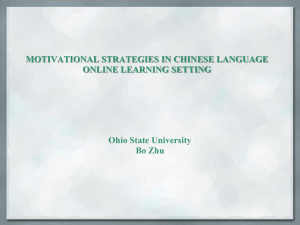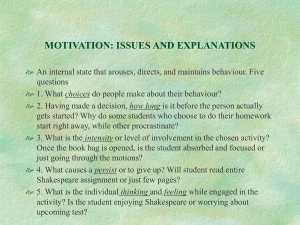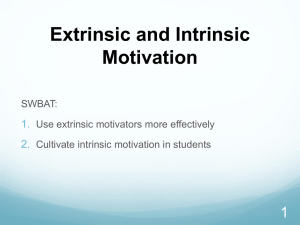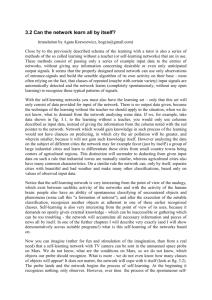Gabriela Gutierrez Motivation and Self
advertisement
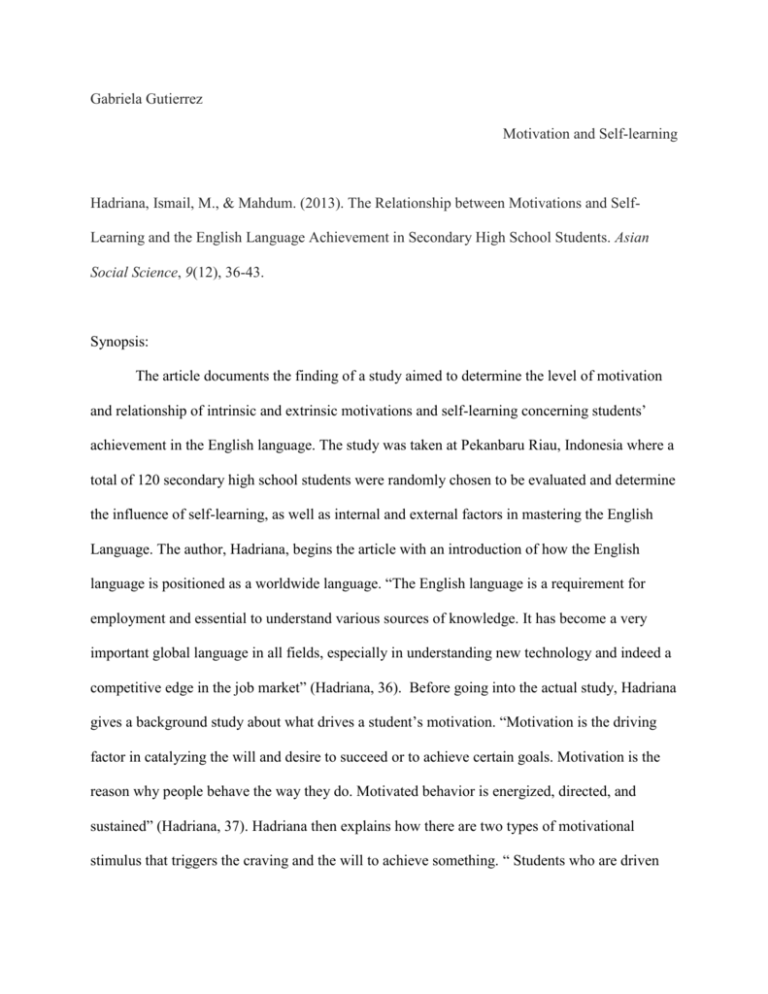
Gabriela Gutierrez Motivation and Self-learning Hadriana, Ismail, M., & Mahdum. (2013). The Relationship between Motivations and SelfLearning and the English Language Achievement in Secondary High School Students. Asian Social Science, 9(12), 36-43. Synopsis: The article documents the finding of a study aimed to determine the level of motivation and relationship of intrinsic and extrinsic motivations and self-learning concerning students’ achievement in the English language. The study was taken at Pekanbaru Riau, Indonesia where a total of 120 secondary high school students were randomly chosen to be evaluated and determine the influence of self-learning, as well as internal and external factors in mastering the English Language. The author, Hadriana, begins the article with an introduction of how the English language is positioned as a worldwide language. “The English language is a requirement for employment and essential to understand various sources of knowledge. It has become a very important global language in all fields, especially in understanding new technology and indeed a competitive edge in the job market” (Hadriana, 36). Before going into the actual study, Hadriana gives a background study about what drives a student’s motivation. “Motivation is the driving factor in catalyzing the will and desire to succeed or to achieve certain goals. Motivation is the reason why people behave the way they do. Motivated behavior is energized, directed, and sustained” (Hadriana, 37). Hadriana then explains how there are two types of motivational stimulus that triggers the craving and the will to achieve something. “ Students who are driven by intrinsic motivation can be seen by their characteristic and propensity towards challenging learning situations. They have more incentive to work to leverage personal satisfaction, rather than trying to get good grades for the sake of getting acknowledgement. An extrinsic motivation on the other hand is driven in students to do something beneficial. Extrinsic motivation is grown from external stimuli in order to move the individual to be more engaging in an activity that will bring great benefit to him” (Hadriana, 38). The problem in this article is that Indonesian students are weak in the English Language and they failed to openly communicate well. The purpose of the study is to identify the student’s ability to acquire the English Language, as a result of intrinsic motivation, extrinsic motivation and self-learning. The way Hadriana conducted the research was using a questionnaire and test. “The intrinsic motivation includes 22 items, extrinsic motivation has 23 items, and self-learning includes 22 items” (Hadriana, 39). The finding in this study were shocking, as the student’s motivation in both intrinsic and extrinsic were both in a moderate high level. “This indicates the existence of internal and external motivations in students’ efforts to understand and acquire the English Language. This is consistent with the view that all students are motivated to learn because of their personal needs and initiatives, and it will be more rewarding rather than learning for the sake of fulfilling others’ needs” (Hadriana, 40). The finding shows that the level of motivation is not enough to help the students to improve their English. Also, the finding of the self-learning shows that their level is at a moderate level, meaning that the students still rely on the teachers as their source of information. “Student achievement in the English Language was found as still at the medium low level based on the results of the study. This indicator signals that the internal and external motives and self-learning are unable to provide much help in improving the skills and English Language proficiency” (Hadriana, 41). The results can improve if the teachers manage to plan and apply effective strategies and capable of making the students enjoy learning the language. Theory The article explains very clearly the two types of motivation and self-learning. This gives the reader an overview of its importance in the study. It begins by first giving several definitions by different psychologists of the meaning of motivation. “According to Azizi Latif Yahaya and Jaafar Sidek, motivation has a significant effect on the areas of growth, development, learning and achievement. Also the opinion stated by Woolfolk that motivation is referred to as an internal power in human, which arouses, directs and controls their interest and behavior” (Hadriana, 37). Hadriana then explains the two different types of motivation and its differences. “The first type of motivation is internal in nature and it is in form of volunteerism driven by pleasure, desire, attitude, interest and the internal factors of an individual. Extrinsic motivation will be a drive in students to do something beneficial. Extrinsic motivation is grown from external stimuli in order to move the individual to be more engaging in an activity that will bring great benefit to him” (Hadriana, 38). Hadriana then defines self-learning as an effective way of a student-centered learning where the teacher’s role is reduced and explaining the benefits that it gives the students by helping them to plan organize and evaluate their own learning. The purpose of defining and explaining these theories is so the reader can know the subject being researched in this article. Even before beginning the research, Hadriana explains how intrinsic motivation, extrinsic motivation and self-learning come into play. “Intrinsic motivation refers to the following aspects of how students direct their learning with clear goals, students’ participation in the English Language learning activities, active seeking for clarification during the lessons, the excitement to perform activities, the proper use of reading techniques, the happy feeling during the lesson, self-satisfaction, no sense of shame in using the language, diligent in learning the language, capable and frequently use the language. Extrinsic motivation covers the aspects of how the external encouragement and motivation help students to understand and acquire the English Language, speaking activities, technology aids, teaching facility, special attention given by teachers and friends, activities and campaigns organized by the school, competitions with the English language counterparts, the influence and role of the media as well as the surrounding community, participation in the English Language contest, teachers’ rues and the needs to meet career demands. Self learning involves several aspects, namely through students learning behaviors in understanding and mastering the English Language, such as self-study, personal learning strategies, self-monitoring of the learning progress, setting up personal target, selfefforts to use the language, self-access for information from the Internet, personal revision, imitating the way other people talk and interact constantly in the English Language, selfchanging personal learning strategies, using the proper way to read and managing a comprehensive study schedule (Hadriana, 39). After the research was conducted the findings revealed that the students had a very moderate high intrinsic and extrinsic motivation and the cause of the students low English proficiency was actually produced by the students’ school environment. Analysis Although Hadriana based her whole study on motivation and self-learning, the results provided evidence that states that students not only have to have good motivation in their study but they much be in a learning environment that inspires and encourages students’ interest. Hadriana does an excellent job in stating and agreeing with several psychologists the meaning of motivation and self-learning. “Motivation is the driving factor in catalyzing the will and desire to succeed or to achieve certain goals. The aspects of self-learning depends on students’ willingness to take responsibility of their own learning; it is closely linked with the meta-cognitive strategies of planning, decision making, monitoring and evaluation” (Hadriana, 38). Hadriana even breaks the motivation concept into the two different types of motivation and deeply explains about them. “Intrinsic motivation is linked with curiosity and inner drive to achieve efficiency for new students in school. Extrinsic motivation is grown from external stimuli in order to move the individual to be more engaging in an activity that will bring great benefit to him” (Hadriana, 38). After the study, it is realized that the students have very moderate high intrinsic and extrinsic motivation and for students to fully understand speaking English there needed the teachers to create a fun and interesting environment for students to learn. Evaluate This is an excellent article that shows how students need a supportive learning environment to inspire and encourage students’ interest with their intrinsic and extrinsic motivation to succeed in the classroom. Hadriana gives a very clear background of the concepts and the study that is very easy to read and understand. Reading the article, the reader will gain knowledge about intrinsic motivation, extrinsic motivation, self- learning, and providing students a supportive learning environment. The article is designed for university students, but can be read by anyone in the education field, as it is very informative and beneficial. “The teaching and learning situation itself should be fair to the students by giving them fair chances to grow their own potentials. Students should be actively involved in the learning and teaching process, as their potentials will fail to grow if they do not fully utilize their senses to apply their personal skills in providing their ideas and talents (Hadriana, 42).



